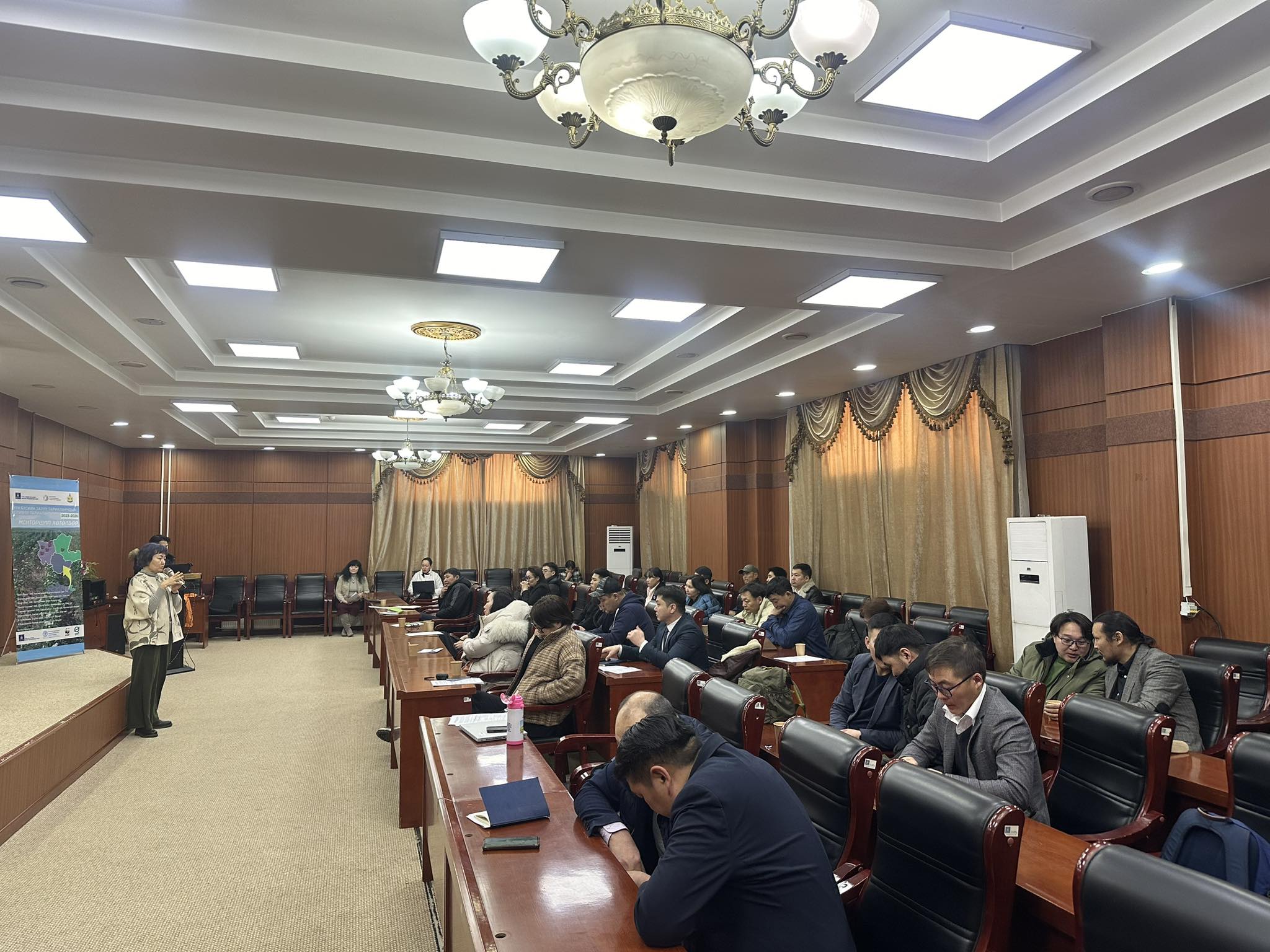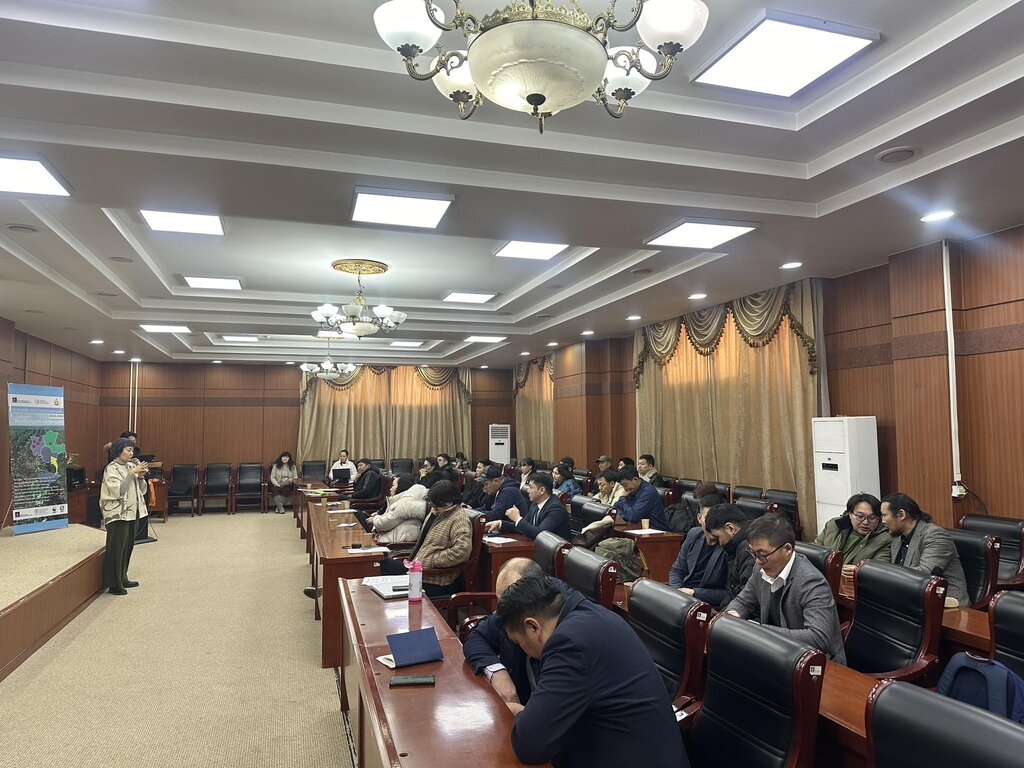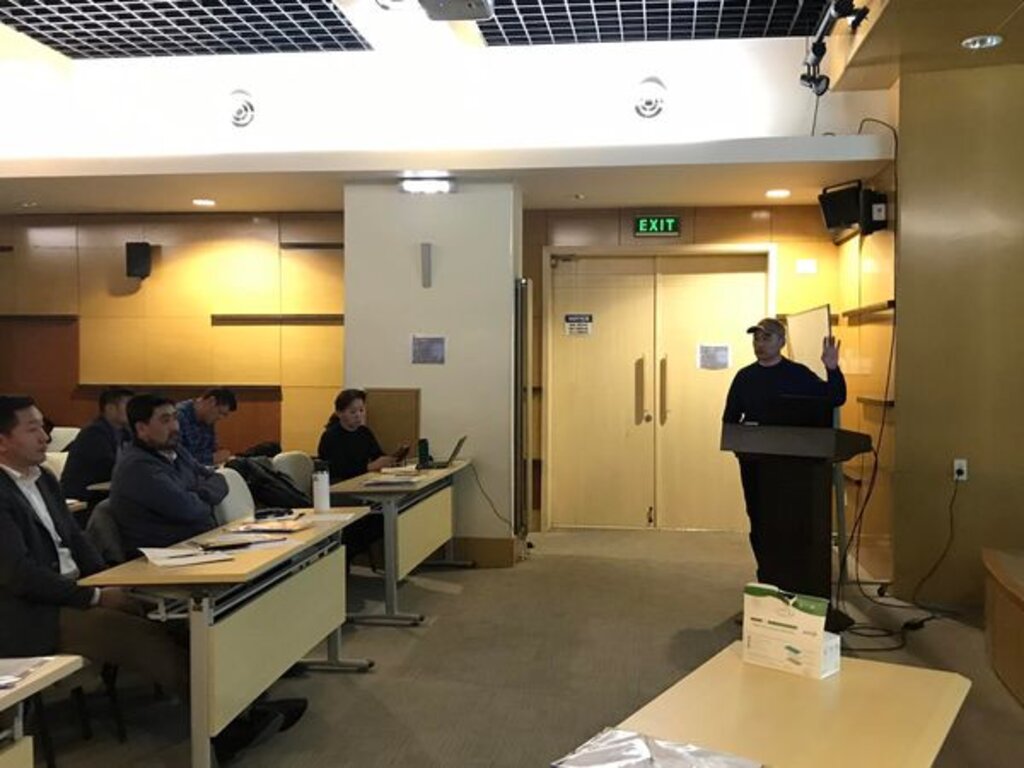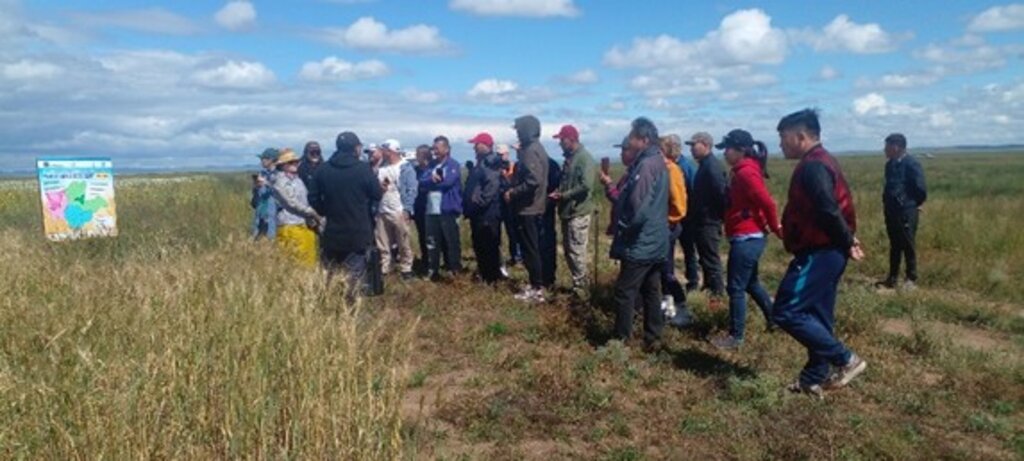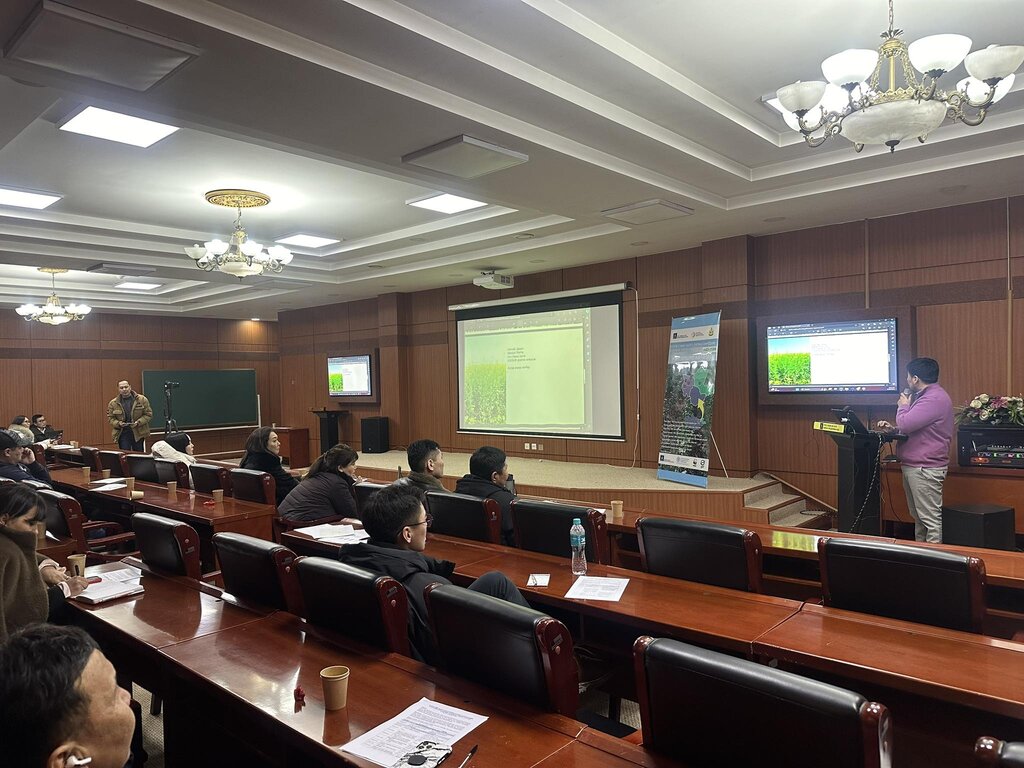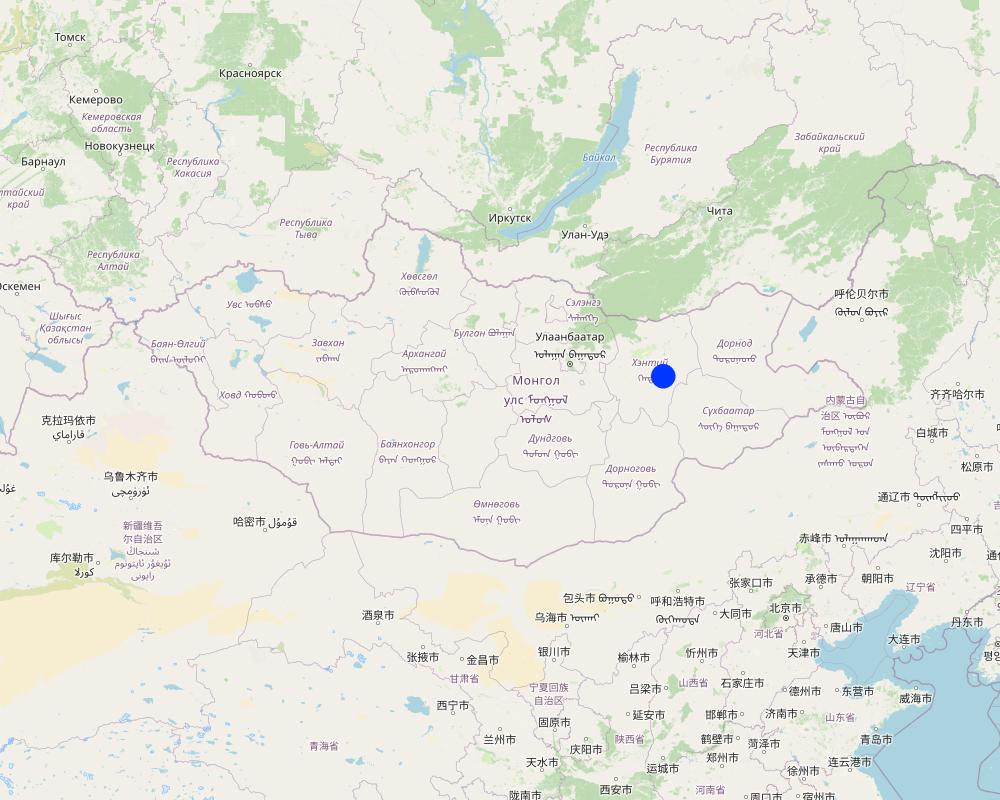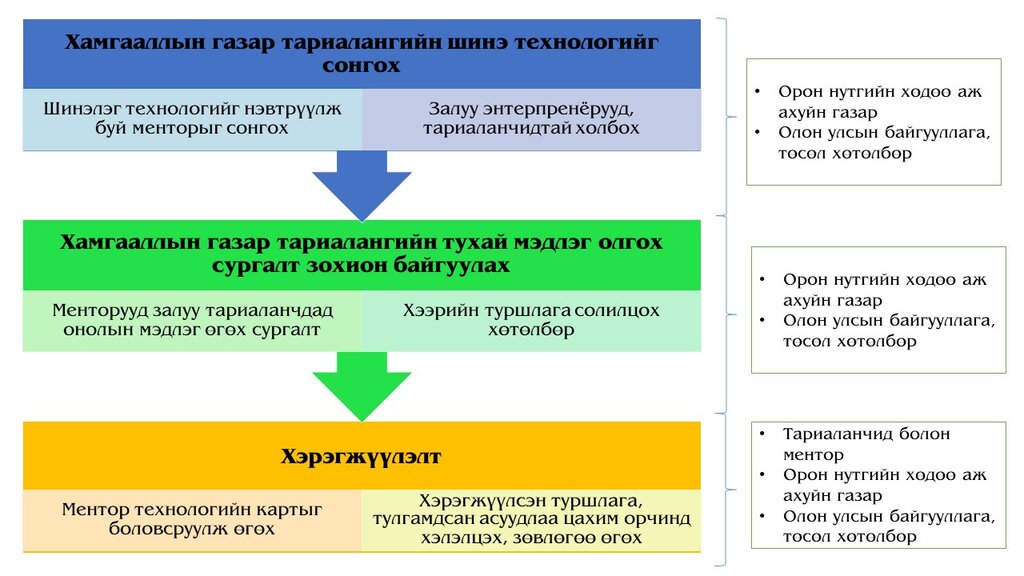Mentorship programme on conservation agriculture [Mongolie]
- Création :
- Mise à jour :
- Compilateur : Otgontsetseg Davaanyam
- Rédacteur : Mandakh Nyamtseren
- Examinateur : Rima Mekdaschi Studer
Zaluu tarialanchiin mentor khutulbur
approaches_6995 - Mongolie
Voir les sections
Développer tout Réduire tout1. Informations générales
1.2 Coordonnées des personnes-ressources et des institutions impliquées dans l'évaluation et la documentation de l'Approche
Personne(s) ressource(s) clé(s)
exploitant des terres:
Batdeleg Batnaran
99372580
dayanbat@gmail.com
Khentii Tarialan LLC
Kherlen soum, Khentii province
Mongolie
organizer:
organizer:
Tsend Oyungerel
80185595
oyungerel.tsend@fao.org
FAO
Mongolie
Nom du projet qui a facilité la documentation/ l'évaluation de l'Approche (si pertinent)
Global coordination project for the SFM Dryland Sustainable Landscapes Impact Program (GEF-FAO / DSL-IP)Nom du ou des institutions qui ont facilité la documentation/ l'évaluation de l'Approche (si pertinent)
Mongolian Academy of Sciences, Institute of Geography and Geoecology (IGG) - Mongolie1.3 Conditions relatives à l'utilisation par WOCAT des données documentées
Quand les données ont-elles été compilées (sur le terrain)?
04/10/2023
Le compilateur et la(les) personne(s) ressource(s) acceptent les conditions relatives à l'utilisation par WOCAT des données documentées:
Oui
1.4 Références au(x) questionnaire(s) sur les Technologies de GDT
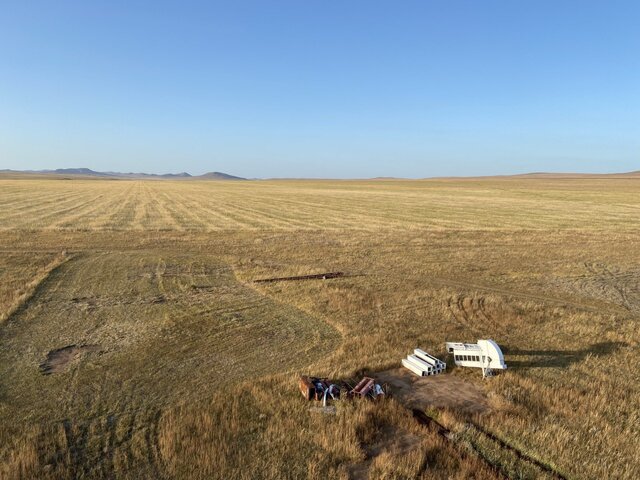
Атаршсан газрыг сэргээж эргэлтэд оруулах хөрс хамгааллын газар … [Mongolie]
Энэхүү технологи нь 1970-1980-аад оны үед өмнө нь газар тариалан, тэжээлийн үйлдвэрлэлд ашиглагдаж байгаад орхигдсон тариалангийн талбайг сэргээхэд чиглэсэн юм. Энэ газарт 2014 оноос газрын доройтлыг бууруулах, хөрсний үржил шимийг сайжруулах, газар тариалангийн үйл ажиллагааг сэргээх, тариалангийн газрын бүтээмжийг нэмэгдүүлэх зорилгоор хамгааллын газар тариалангийн нэг арга болох холимог тариаланг эрхэлж …
- Compilateur : Otgontsetseg Davaanyam
2. Description de l'Approche de GDT
2.1 Courte description de l'Approche
The Approach aims to ensure the sustainability of the agricultural sector by training and mentoring young farmers in conservation agriculture to improve soil fertility and health and maintain productivity.
2.2 Description détaillée de l'Approche
Description détaillée de l'Approche:
Within the framework of the mentorship programme, companies introducing innovative technologies in the agricultural discipline such as conservation agriculture, are selected as mentors and connected with young entrepreneurs who are new to this type of activities. Based on main principles of mentorship, the conservation agriculture training and mentorship program aims to transfer knowledge and skills gained from real-life experiences, lessons learnt, failures, and success stories from the experienced farmers to young farmers.
The mentors develop a technology card, showing main steps how to apply the technology to the young farmers. Farmers further share their experiences and knowledge gained during technology adoption through group chats and group pages on the social media, giving advice on how to fix any problems and uploading their stories on how they overcame problems in the same situation. The mentorship program involves workshops combined with in-person training to provide fundamental understanding of the SLM technology and practical field visits.
In order to empower young farmers, the Mongolian National Crop Farmers Association organized an introductory training course on mixed cropping technology and conservation agriculture (CA) in 2022. As a result of the training, young farmers who were interested in this technology became members of the mentorship program with the condition that they modify their equipment, machinery and field specifications/requirements (e.g. fencing and leaving cover on the soil surface) to adapt to CA. Total of 9 companies from nearby provinces, Dornod and Khentii, participated in the program as mentees. The mentorship program on Mixed Cropping and CA is led by Khentiin Tarialan LLC which is successfully implementing these technologies in Khentii province.
In order to sustainably maintain the mentorship program, the Mongolian National Crop Farmers Association and the project "Promoting Dryland Sustainable Landscapes and Biodiversity Conservation in the Eastern Steppe of Mongolia" implemented by FAO and WWF organize workshops for young farmers in the non-agricultural season (winter) and conduct field visits before the agricultural season (spring) every year, helping to spread good practice and knowledge.
In 2023, the mentor gave methodological advice to young farmers during a classroom lecture on how to maintain plant health, develop mixed cropping and crop rotationmaps, take soil samples with specific equipment, and how to check crop quality followed by a field visit during which participants obtained knowledge about positive impacts of mixed cropping and CA on soil restoration and financial benefits as well as at first year results, lessons learnt (success and failures) and problems encount. A total of 129 farmers from Dornod, Khentii, Sukhbaatar, Darkhan, Bulgan, Tuv and Selenge provinces participated in this training.
In addition, a closed group has been set up to share information using social networking sites, and a mentor uploads short videos on the internet to introduce the technology to people who are interested. In the future, it is planned to increase the number of mentors and topics.
Because this program is organized on a need-based and volunteer basis, parties participate with a positive attitude. Basic requirements including financial support, communication and cooperation are needed to support and sustain the implementation of the program.
2.3 Photos de l'approche
2.4 Vidéos de l'Approche
Commentaire, brève description:
During the field visit, the mentor introduces conservation agriculture to the participants. The video was created by a project titled "Promoting dryland sustainable landscapes and biodiversity conservation in the Eastern Steppes of Mongolia".
Lieu:
Kherlen soum, Khentii province
Nom du vidéaste:
"Promoting dryland sustainable landscapes and biodiversity conservation in the Eastern Steppes of Mongolia" project
2.5 Pays/ région/ lieux où l'Approche a été appliquée
Pays:
Mongolie
Région/ Etat/ Province:
Khentii province, Kherlen soum
Autres spécifications du lieu :
Takhilgat bag
Map
×2.6 Dates de début et de fin de l'Approche
Indiquez l'année de démarrage:
2022
Si l'année précise est inconnue, indiquez approximativement quand l'Approche a démarré:
il y a moins de 10 ans (récemment)
Commentaires:
This approach is still ongoing.
2.7 Type d'Approche
- initiative/ innovation récente locale
2.8 Principaux objectifs de l'Approche
The primary objective is to establish a knowledge-sharing and training network for farmers, enabling them to exchange their observations, achievements, and challenges gathered from actual experiences, and to introduce modern agricultural technologies that are resilient to climate change and have a positive impact on soil and biodiversity.
2.9 Conditions favorisant ou entravant la mise en œuvre de la(des) Technologie(s) appliquée(s) sous l'Approche
disponibilité/ accès aux ressources et services financiers
- entrave
Not every farmer has the opportunity to upgrade his/her machinery and take advantage of bank subsidy programs. For circulation and investment purposes banks lend to food and agricultural enterprises low loans with interest rates from about 5 to 8 per cent and 5-15 billion tugruks for 2-7 years (2023).
cadre institutionnel
- favorise
The Ministry of Food, Agriculture and Light Industry and local administration, UNDP-FAO, General department of Land Planning, Geodesy and Mapping support the mentorship program.
collaboration/ coordination des acteurs
- favorise
As a result of the collaboration among the UNDP-FAO, WWF and Khentiin Tarialan LLC, other farmers can share their experiences and knowledge.
cadre politique
- favorise
The agricultural policy at national and local level may support multi-species agriculture with high-productivity, because of their positive effects on soil protection and sustainable use. The local administrative support entities aimed to rehabilitate degraded land by renting land and providing soft loan.
gouvernance foncière (prise de décisions, mise en œuvre et application des décisions)
- favorise
It is a form of support to include it in local land management planning.
connaissances sur la GDT, accès aux supports techniques
- favorise
Volunteer members of the mentoring program facilitate knowledge sharing and give technical support.
marchés (pour acheter les intrants, vendre les produits) et prix
- entrave
Main factor affecting costs is inflation. Thus, it can have a great effect on purchasing equipment, seeds and other input. Currently, there is no demand of some of the crops on the market (e.g. flax).
charge de travail, disponibilité de la main-d'œuvre
- favorise
The implementing conservation agricultural technologies has the potential to reduce labour costs related to pest control, herbicide and fertilizer application
3. Participation et rôles des parties prenantes impliquées dans l'Approche
3.1 Parties prenantes impliquées dans l'Approche et rôles
- exploitants locaux des terres / communautés locales
Local agricultural companies and young farmers. Currently, a total of 9 agricultural companies from Dornod and Khentii provinces are participating in this program.
Exchange and enhance knowledge, connect problems and find solutions together. They are responsible for monitoring soil quality change in their field.
- Spécialistes de la GDT/ conseillers agricoles
Batnaran B., Mongolian, farmer. He implements mixed cropping and Conservation Agriculture in Kherlen soum, Khentii province. Currently, he is the only mentor, sharing his knowledge and training other participants. More mentors are planned to become involved.
Develop technical cards, present technological solutions, give advice and information on social networks, host Facebook group and Youtube channel.
- ONG
Mongolian National Crop Farmers Association
Organize training courses and meetings, distribute information and offer networking space for participants and farmers.
- gouvernement local
The Department of Food and Agriculture in Khentii province
Provide policy support related to land tenure and provide loan for farmers, disseminate information about mentorship program, carry out external monitoring on yield, and methodological recommendations for farmers.
- organisation internationale
UNDP-FAO, WWF
International organizations provide financial support to organize meeting and practical training. These activities help to improve communication between farmers, broaden participant range, disseminate information on technology. Also, they provided variety of seeds that were not commonly planted in Mongolia - so that farmers can create their own seed bank.
Si plusieurs parties prenantes sont impliquées, indiquez l'organisme chef de file ou l'institution responsable:
Under the goal of revitalizing the agricultural sector of the province, the Department of Food and Agriculture in Khentii province demonstrate leadership on policy level and policy implementation.
3.2 Participation des exploitants locaux des terres/ communautés locales aux différentes phases de l'Approche
| Participation des exploitants locaux des terres/ communautés locales | Spécifiez qui était impliqué et décrivez les activités | |
|---|---|---|
| initiation/ motivation | auto-mobilisation | As a result of the first regional meeting, the farmers were motivated to introduce new technologies and joined the initiative to develop their farms properly under the guidance and support of the mentor. |
| planification | aucun | The training course and meetings are mainly organized by the Mongolian National Crop Farmers Association, International Organizations and the Department of Food and Agriculture of Khentii province. |
| mise en œuvre | auto-mobilisation | Farmers began the process of upgrading or adapting their machinery according to the mentor's recommendations and started to plant according to the technological card prepared by the mentor. |
| suivi/ évaluation | passive | As the initiative is still in its beginning phase, local communities have not been directly involved in monitoring and evaluation of the Approach. But farmers implementing the conservation agricultural technology evaluate changes in soil quality and biodiversity through observation and soil sample analysis. In addition, agricultural specialists of local government evaluate the process of mentorship program based on report. |
| learn/research | interactive | Land users have gained knowledge and experience through the use of printed and electronic resources and applying in their field. |
3.3 Diagramme/ organigramme (si disponible)
Description:
Implementation phases of knowledge sharing network and mentorship program in conservation agriculture.
Auteur:
Otgontsetseg D.
3.4 Prises de décision pour la sélection de la Technologie/ des Technologies
Indiquez qui a décidé de la sélection de la Technologie/ des Technologies à mettre en œuvre:
- principalement les exploitants des terres soutenus par des spécialistes de la GDT
Spécifiez sur quelle base ont été prises les décisions:
- les résultats de recherches?
- expériences et opinions personnelles (non documentées)
4. Soutien technique, renforcement des capacités et gestion des connaissances
4.1 Renforcement des capacités/ formation
Une formation a-t-elle été dispensée aux exploitants des terres/ autres parties prenantes?
Oui
Spécifiez qui a été formé:
- exploitants des terres
Formats de la formation:
- sur le tas
- entre agriculteurs (d'exploitants à exploitants)
- zones de démonstration
- réunions publiques
Thèmes abordés:
Under the topic of conservation agriculture and its special technologies to implement, methods such as crop rotation, intercropping, mixed cropping, and leaving plant stubbles and residues in/on the soil, how they are implemented, their advantages and disadvantages were introduced.
Commentaires:
The training program comprises two sessions: a theoretical session in a dedicated room, during which the participants are introduced to the concept of conservation agriculture and its potential advantages and disadvantages; and a practical demonstration area, where the participants can observe the implementation of technology in action. Moreover, training participants discuss their own experiences during public meetings and mentor gives personal advice to participants when necessary.
4.2 Service de conseils
Les exploitants des terres ont-ils accès à un service de conseils?
Oui
Spécifiez si le service de conseils est fourni:
- dans les champs des exploitants?
- Social network
Décrivez/ commentez:
Land users can take methodological advice from a mentor as well as specialists from local government. Within a limited group and based on social networks, there was an opportunity to receive advice on relevant issues from time to time.
4.3 Renforcement des institutions (développement organisationnel)
Des institutions ont elles été mises en place ou renforcées par le biais de l'Approche?
- non
4.4 Suivi et évaluation
Le suivi et l'évaluation font ils partie de l'Approche? :
Oui
Commentaires:
The farmers implementing the technology monitor changes in soil quality through observation and soil sample analysis. Soil samples collected from field are analyzed in an accepted laboratory. Local government institution does external monitoring on the Approach.
Si oui, ce document est-il destiné à être utilisé pour le suivi et l'évaluation?
Non
4.5 Recherche
La recherche a-t-elle fait partie intégrante de l’Approche?
Oui
Spécifiez les thèmes:
- technologie
Donnez plus de détails et indiquez qui a mené ces recherches:
To implement the technology, the farmer reviewed literature from many national and international sources. In addition, he had contact with scientists, who helped in deciding what and how to implement.
5. Financement et soutien matériel externe
5.1 Budget annuel de la composante GDT de l'Approche
Indiquez le budget annuel de la composante GDT de l'Approche en $ US:
4430,00
Si le budget annuel précis n'est pas connu, indiquez une fourchette:
- 2 000-10 000
Commentez (par ex. principales sources de financement/ principaux bailleurs de fonds):
Total annual budget of technology is approximately MNT 165.5 million or $ 48 000. This includes labor, implementation of the technology, fuel, purchase of seeds, etc. as well as organization of training courses, field visits, networking and backstopping, monitoring costs and all other expenses.
5.2 Soutiens financiers/ matériels fournis aux exploitants des terres
Les exploitants des terres ont-ils reçu un soutien financier/ matériel pour la mise en œuvre de la Technologie/ des Technologies?
Non
5.3 Subventions pour des intrants spécifiques (incluant la main d'œuvre)
- équipement
| Spécifiez les intrants subventionnés | Dans quelle mesure | Spécifiez les subventions |
|---|---|---|
| machines | en partie financé | None |
Si la main d'œuvre fournie par les exploitants des terres était un intrant substantiel, elle était:
- volontaire
5.4 Crédits
Des crédits ont-ils été alloués à travers l'Approche pour les activités de GDT?
Oui
Spécifiez les conditions (taux d'intérêts, remboursements, etc.):
The Mongolian government has decided to provide an investment loan with purpose of supporting the food and agricultural industry in 2023. The credit grants 3-5 year loans with an interest rate of 5-6 percent to farmers in order to improve circulating capital and investment. The credit volume ranges from 5 to 15 billion MNT, depending on the bank and the size of the farm.
Spécifiez les fournisseurs du crédit:
The Mongolian government has signed an agreement with 10 commercial banks in Mongolia. The banks are offering soft loans with an interest rate of 5-6 percent, while the Ministry of Food and Agriculture is covering the gap between interest rates, charging 13 percent.
Spécifiez les destinataires du crédit:
It can be an individual land user or farmer, a group such as user groups or associations and/ or a cooperative.
5.5 Autres incitations ou instruments
D'autres incitations ou instruments ont-ils été utilisés pour promouvoir la mise en œuvre des Technologies de GDT?
Oui
Si oui, spécifiez:
Participants were eligible for subsidized loan from the Agricultural Development Fund which has ended in 2023. The Agricultural Corporation was established in 2021 by the Mongolian government. The Agricultural Corporation is a state-owned limited liability company that provides necessary products for the agricultural development of Mongolia with discounted prices and loans to farmers, allowing to repay the loans with the products produced by them. The corporation is mainly responsible for purchasing all kinds of seeds, fertilizers, plant protection substances, fuel, machinery and equipment from the domestic and international market. The farmers have the possibility to purchase equipment with discount price.
6. Analyses d'impact et conclusions
6.1 Impacts de l'Approche
Est-ce que l'Approche a autonomisé les exploitants locaux des terres, amélioré la participation des parties prenantes?
- Non
- Oui, un peu
- Oui, modérément
- Oui, beaucoup
The mentorship program enabled participants to gain knowledge and experience in conservation agriculture and land restoration by organizing trainings, field visits, meetings and discussions, a fundamental basis for the successful implementation of the technology. Moreover, it supports communication and collaboration among the different stakeholders such as local administration, international organization, companies and local land users.
Est-ce que l'Approche a permis la prise de décisions fondées sur des données probantes?
- Non
- Oui, un peu
- Oui, modérément
- Oui, beaucoup
Because first-hand experience of conservation agriculture in the field is shared through the mentorship programme, farmers make their decision to adopt conservation agriculture based on the knowledge they have gained from training, the technical and financial support they can receive.
Est-ce que l'Approche a aidé les exploitants des terres à mettre en œuvre et entretenir les Technologies de GDT?
- Non
- Oui, un peu
- Oui, modérément
- Oui, beaucoup
The mentorship program allows for the dissemination of knowledge about conservation agriculture, including both the establishment and the long-term maintenance of such practices. Furthermore, the farmers participating in the mentorship programme can seek advice through a social network and direct contact with a mentor. By sharing knowledge about conservation agriculture with other farmers, advantages, disadvantages and potential of the technology are shown, as well as the long-term efficiency and benefits for land restoration.
Est-ce que l'Approche a amélioré la coordination et la mise en œuvre de la GDT selon un bon rapport coût-efficacité?
- Non
- Oui, un peu
- Oui, modérément
- Oui, beaucoup
Conservation agriculture is a Арin the long term.
Est-ce que l'Approche a amélioré les connaissances et les capacités des exploitants des terres pour mettre en œuvre la GDT?
- Non
- Oui, un peu
- Oui, modérément
- Oui, beaucoup
A main goal is to improve and share knowledge about Conservation Agriculture. A mentor shares his knowledge with other land users, helping them to build and enhance their experience and knowledge.
Est-ce que l'Approche a amélioré les connaissances et les capacités des autres parties prenantes?
- Non
- Oui, un peu
- Oui, modérément
- Oui, beaucoup
The meeting, organized in 2023, involved all stakeholders and presented the results of the mentorship program as well as of Conservation Agricultural and its related technologies.
Est-ce que l'Approche a construit/ renforcé les institutions, la collaboration entre parties prenantes?
- Non
- Oui, un peu
- Oui, modérément
- Oui, beaucoup
The Approach improved collaboration between stakeholders by organizing joint meetings and discussions. Generally, Mongolian National Crop Farmers Association and WWF -Mongolia jointly organize the training and meetings. Local government, farmers, international and non-governmental organizations discuss their results and problems to each other during the meeting. It allows to support further collaboration.
Est-ce que l'Approche a encouragé les jeunes/ la prochaine génération d'exploitants des terres à s'engager dans la GDT?
- Non
- Oui, un peu
- Oui, modérément
- Oui, beaucoup
The mentorship program aims to involve mainly young farmers.
Est-ce que l'Approche a amélioré la capacité des exploitants des terres à s'adapter aux changements/ extrêmes climatiques et a atténué les catastrophes liées au climat?
- Non
- Oui, un peu
- Oui, modérément
- Oui, beaucoup
The Approach enhanced capacity of young farmers through training them on Conservation Agriculture, which improves resilient to climate change and disasters.
6.2 Principale motivation des exploitants des terres pour mettre en œuvre la GDT
- augmenter la production
Abandoned land was put under production using CA. Hence soil fertility, moisture and health are enhanced which and crop production gradually increases.
- augmenter la rentabilité/ bénéfice, rapport coûts-bénéfices
The less application of pesticides and fertilizers, coupled with a reduction in the workload, leads to improve cost-benefit-ratio.
- réduire la dégradation des terres
CA promotes maintenance of a permanent soil cover, minimum soil disturbance, and diversification of plant species (FAO). Thus, it reduces land degradation by wind and water erosion.
- réduire les risques de catastrophe
Permanent cover can help to reduce the risk of flooding or sand and dust storms.
- réduire la charge de travail
CA reduces workload because of reduced ploughing and direct seeding. Application of fertilizers and herbicides/ pesticides to control weeds, diseases and pests is at minimum.
- conscience environnementale
CA leads people to protect and restore soil and biodiversity.
- améliorer les connaissances et compétences en GDT
CA allows people to use land efficiently over the long-term, simultaneously ensuring the maintenance of its environmental functions. These technologies are crucial for sustainable land management as they enhance soil fertility, prevent erosion, and increase water retention. Thus, land users can obtain knowledge about SLM through implementation of CA.
6.3 Durabilité des activités de l'Approche
Les exploitants des terres peuvent-ils poursuivre ce qui a été mis en œuvre par le biais de l'Approche (sans soutien extérieur)?
- oui
Si oui, décrivez de quelle manière:
Previously, a mentor provided advice and knowledge to other farmers through a social network and direct contact. Financial support from international organizations has enabled more farmers to participate in the mentorship program. Further, the local government can organize training, and also the mentor can personally run this program through the social network and extension center. The number of people who are interested in mentorship program is gradually increasing.
6.4 Points forts/ avantages de l'Approche
| Points forts/ avantages/ possibilités du point de vue de l'exploitant des terres |
|---|
| The mentorship programme supports farmers in implementing Conservation Agriculture by training them in fundamental knowledge, particularly it involves young farmers who are the future land users. |
| Young farmers can quickly learn about Conservation Agricultural saving time and can get instructions and advice directly from a mentor with real experiences. |
| It is possible to disseminate knowledge to more people on a small budget. |
| Communication between farmers and collaboration between organizations can be improved by the Approach. During the meetings and field visits, problems and successes are discussed and experiences shared. |
| Points forts/ avantages/ possibilités du point de vue du compilateur ou d'une autre personne ressource clé |
|---|
| It is a fast way to practice young farmers in implementing conservation agriculture. |
| The social network allows participants to quickly share knowledge and experiences with each other and easily communicate with a mentor. |
| Understanding CA from people who have implemented CA. Farmers are motivated to implement conservation agriculture because of its sustainability. |
| It provides the opportunity to solve problems as a team, collecting different experiences and solutions. |
6.5 Faiblesses/ inconvénients de l'Approche et moyens de les surmonter
| Faiblesses/ inconvénients/ risques du point de vue de l’exploitant des terres | Comment peuvent-ils être surmontés? |
|---|---|
| In order to organize training in wide range, it needs financial support. | Financial support from other sources, including international organizations and projects. |
| Implementing CA requires farmers to adapt their equipment to the technology, which has a high initial cost. | There are soft loans from banks to support sustainable land use. The farmers can get this kind of loan. |
| Faiblesses/ inconvénients/ risques du point de vue du compilateur ou d'une autre personne ressource clé | Comment peuvent-ils être surmontés? |
|---|---|
| The training course and the field visit require a certain amount of money. Thus, the mentorship program may slow down without financial support. | It needs to get financial support or participants can give payment for the programme. |
| It requires coordination to plan trainings and field visits, and means of communication to reach farmers. | To work consistently with local government and farmers. |
| Currently, there is only one mentor training farmers. Therefore, the number of mentors with different experiences needs to be increased. | To detect new mentors with experience of conservation agriculture. |
7. Références et liens
7.1 Méthodes/ sources d'information
- interviews/entretiens avec les exploitants des terres
Mentor gave general information.
- Organizers
Two informants from the international organizations supporting the mentorship programme were interviewed. They provided information about training, meeting, participants and cost.
7.3 Liens vers les informations pertinentes disponibles en ligne
Titre/ description:
Youtube channel hosted by mentor
URL:
https://www.youtube.com/@covercropmongolia9564
Titre/ description:
Facebook page sharing experiences on social network
URL:
https://www.facebook.com/profile.php?id=100063508026054
Liens et modules
Développer tout Réduire toutLiens

Атаршсан газрыг сэргээж эргэлтэд оруулах хөрс хамгааллын газар … [Mongolie]
Энэхүү технологи нь 1970-1980-аад оны үед өмнө нь газар тариалан, тэжээлийн үйлдвэрлэлд ашиглагдаж байгаад орхигдсон тариалангийн талбайг сэргээхэд чиглэсэн юм. Энэ газарт 2014 оноос газрын доройтлыг бууруулах, хөрсний үржил шимийг сайжруулах, газар тариалангийн үйл ажиллагааг сэргээх, тариалангийн газрын бүтээмжийг нэмэгдүүлэх зорилгоор хамгааллын газар тариалангийн нэг арга болох холимог тариаланг эрхэлж …
- Compilateur : Otgontsetseg Davaanyam
Modules
Aucun module trouvé


